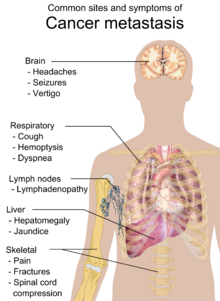Tumors form advance teams to ready lungs for spread of cancer
Cancer metastasis requires tumor cells to acquire properties that allow them to escape from the primary tumor site, travel to a distant place in the body, and form secondary tumors. But first, an advance team of molecules produced by the primary tumor sets off a series of events that create a network of nurturing blood vessels for arriving primary tumor cells to set up shop.
In lung cancer, the formation of that niche likely involves immune cells and moderate levels of VEGF and other molecules that promote the formation of new blood vessels, or angiogenesis. But little is known about how the local lining, or endothelial, cells are activated at the niche.
Sandra Ryeom, PhD, assistant professor of Cancer Biology, Perelman School of Medicine, University of Pennsylvania, and colleagues, found that the signaling protein calcineurin upregulates another molecule, Ang-2 that promotes the needed angiogenesis. Hyperactivation of calcineurin in genetically altered mice that lack an inhibitior of calcineurin signaling leads to increased lung metastases. Conversely, inhibiting calcineurin or Ang-2 blocked metastases in lung cells of the mice. The findings are published this week in Cell Reports.
The findings may help shed light on the underpinnings of common cancer metastasis patterns, such as the tendency of prostate cancer to spread to the bones, or melanoma to the brain.
“We demonstrated that the calcineurin pathway is activated specifically in lung endothelium prior to the detection of tumor cells that preferentially and spontaneously metastasize to the lung from our experimental model of flank tumors in mice,” says Ryeom.
Also, increased VEGF levels specifically in the lung, and not other organ microenvironments, trigger a threshold amount of calcineurin signaling that activates the Ang2 gene in lung endothelial cells. What’s more, they showed that overexpression of the Ang-2 receptor prevents activation of the lung endothelium and inhibits lung metastases in their mouse models.
 “Our studies provide insights into the mechanisms underlying angiogenesis in the pre-metastatic niche and offer new targets for lung metastases,” she says.
“Our studies provide insights into the mechanisms underlying angiogenesis in the pre-metastatic niche and offer new targets for lung metastases,” she says.
Because calcineurin acts on the pathways that set up sites of metastasis away from the primary tumor sites, it could be a potential target for future cancer therapies; however it is also active in the immune system. In fact, calcineurin is inhibited by cyclosporine, which is used to combat transplant rejection, so using these types of drugs would be tricky for cancer unless they can be targeted specifically towards endothelial cells.
 Ongoing studies in the Ryeom lab are investigating whether calcineurin is important for metastases in other organs or whether this pathway is specific for lung metastases.
Ongoing studies in the Ryeom lab are investigating whether calcineurin is important for metastases in other organs or whether this pathway is specific for lung metastases.
###
Co authors are Takashi Minami, Tatsuhiko Kodama, Jun-ichi Suehiro, Tsuyoshi Osawa, and Mai Miura, The University of Tokyo; Shuying Jiang, Makoto Naito, Nigata University, Japan; Yuichi Oike, Kumamoto University, Japan; and Keri Schadler, from Penn.
This research was supported by the National Cancer Institute (P01 CA045548, R01 CA118374), the Leading-edge Research Promotion fund, the Japan Society (LS038), The Garrett B. Smith Foundation, and the TED-driven Foundation.
Penn Medicine is one of the world’s leading academic medical centers, dedicated to the related missions of medical education, biomedical research, and excellence in patient care. Penn Medicine consists of the Raymond and Ruth Perelman School of Medicine at the University of Pennsylvania (founded in 1765 as the nation’s first medical school) and the University of Pennsylvania Health System, which together form a $4.3 billion enterprise.
The Perelman School of Medicine has been ranked among the top five medical schools in the United States for the past 16 years, according to U.S. News & World Report’s survey of research-oriented medical schools. The School is consistently among the nation’s top recipients of funding from the National Institutes of Health, with $398 million awarded in the 2012 fiscal year.
The University of Pennsylvania Health System’s patient care facilities include: The Hospital of the University of Pennsylvania—recognized as one of the nation’s top “Honor Roll” hospitals by U.S. News & World Report; Penn Presbyterian Medical Center; and Pennsylvania Hospital - the nation’s first hospital, founded in 1751. Penn Medicine also includes additional patient care facilities and services throughout the Philadelphia region.
Penn Medicine is committed to improving lives and health through a variety of community-based programs and activities. In fiscal year 2012, Penn Medicine provided $827 million to benefit our community.
###
Karen Kreeger
karen.kreeger@uphs.upenn.edu
215-349-5658
University of Pennsylvania School of Medicine